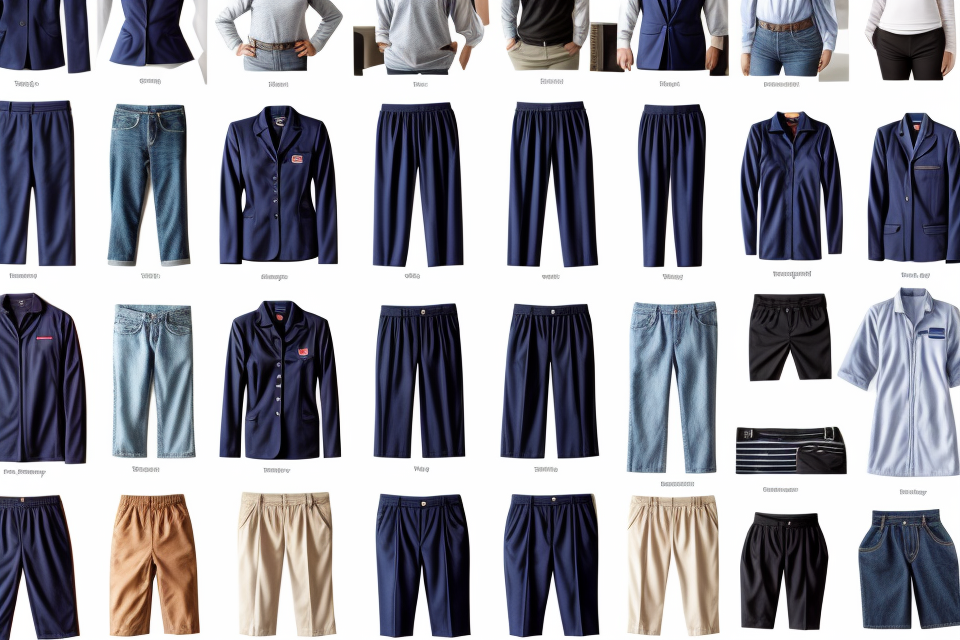
Uniforms are an essential part of any profession, whether it be in the military, healthcare, or hospitality industry. However, one common problem with wearing a uniform is that it may not fit perfectly, which can be uncomfortable and unflattering. But don’t worry, with a few simple tips and tricks, you can make your uniform fit like a glove. In this article, we will explore the best methods for creating a uniform fit that is both comfortable and stylish. From altering store-bought uniforms to custom-making your own, we’ve got you covered. So, let’s get started and learn how to create a uniform fit for a perfect look!
Understanding Uniform Fits
Importance of a Well-Fitted Uniform
A well-fitted uniform is essential for creating a perfect look. Here are some reasons why:
Improved Appearance
A well-fitted uniform can help to create a polished and professional appearance. When a uniform fits well, it can enhance the overall look of the wearer and make them appear more put-together and polished. This can be especially important for those in customer-facing roles, as a well-fitted uniform can help to create a positive first impression.
Professionalism
A well-fitted uniform can also contribute to a sense of professionalism. When a uniform is ill-fitting or poorly made, it can detract from the overall professionalism of the wearer. On the other hand, a well-fitted uniform can help to project an image of competence and professionalism, which can be especially important in industries such as healthcare, law enforcement, and hospitality.
Enhanced Confidence
Finally, a well-fitted uniform can help to enhance confidence. When a uniform fits well, it can help the wearer to feel more confident in their appearance and in their abilities. This can be especially important for those in leadership roles, as a sense of confidence can help to inspire confidence in others. Additionally, feeling confident in one’s appearance can help to reduce stress and anxiety, which can be especially important in high-pressure situations.
Factors Affecting Uniform Fit
When it comes to creating a uniform fit that looks perfect, there are several factors that must be taken into consideration. These factors include body type, fabric type, and uniform design.
- Body Type: The first factor that affects the fit of a uniform is body type. Different body types require different fits in order to look their best. For example, someone with a larger body type may need a uniform that is looser fitting in order to avoid looking overwhelmed by the fabric. On the other hand, someone with a smaller body type may need a uniform that is more fitted in order to create a more streamlined look.
- Fabric Type: Another factor that affects the fit of a uniform is the type of fabric used. Different fabrics have different properties that can affect how a uniform fits. For example, a uniform made from a heavy, thick fabric may require a different fit than a uniform made from a light, breathable fabric. The type of fabric used can also affect how the uniform looks and feels when worn.
- Uniform Design: The design of the uniform itself can also affect how it fits. Different uniform designs may require different fits in order to look their best. For example, a uniform with a lot of intricate details may require a more fitted look in order to avoid looking bulky or overwhelming. On the other hand, a uniform with simpler design elements may be able to get away with a looser fit.
In order to create a uniform fit that looks perfect, it is important to take all of these factors into consideration. By considering body type, fabric type, and uniform design, you can create a uniform that not only fits well, but also looks great and feels comfortable to wear.
Measuring for a Uniform Fit
Taking Accurate Measurements
Accurate measurements are the foundation of creating a uniform fit that looks perfect. Without accurate measurements, your uniform may not fit properly, and you may end up looking disheveled or unprofessional. Therefore, it is crucial to take accurate measurements when creating a uniform fit.
Importance of Accuracy
Accuracy is critical when taking measurements because even the slightest error can result in a poor fit. When taking measurements, it is essential to be precise and ensure that the measurements are taken correctly. This is because uniforms are typically made to specific sizes, and if the measurements are not accurate, the uniform may not fit properly.
Tools and Methods for Taking Measurements
There are various tools and methods that you can use to take accurate measurements. One of the most common tools used is a tailor’s tape measure. This tool is designed to be accurate and easy to use, making it an excellent choice for taking measurements.
Another tool that you can use is a dressmaker’s tape measure. This tool is similar to a tailor’s tape measure but is more flexible and can be used to take measurements in awkward areas.
When taking measurements, it is essential to use the correct method. The most common method is to measure around the body in key areas such as the chest, waist, and hips. It is also important to measure the length of the arms and legs to ensure that the uniform fits correctly.
Additionally, it is important to take multiple measurements in each area to ensure that the measurements are accurate. Taking measurements in the morning when the body is at its most relaxed is also recommended.
In conclusion, taking accurate measurements is crucial when creating a uniform fit that looks perfect. By using the right tools and methods, you can ensure that your measurements are precise and accurate, resulting in a uniform that fits you perfectly.
Alterations and Adjustments
When it comes to creating a uniform fit that is perfect for you, alterations and adjustments are often necessary. Here are some common alterations and tips for making adjustments to ensure a perfect fit:
Common Alterations
Shortening or Lengthening Sleeves
One of the most common alterations is shortening or lengthening sleeves. This can be done by taking the sleeve in or letting it out at the cuff. To shorten sleeves, remove a small amount of fabric at the cuff and then re-sew it. To lengthen sleeves, add more fabric to the cuff and then re-sew it.
Taking in the Waist
Another common alteration is taking in the waist. This can be done by sewing a line of stitches around the waist and then tightening the fabric. To take in the waist, measure the circumference of your waist and add an inch or two for comfort. Then, sew a line of stitches around the waist at this measurement and tighten the fabric as needed.
Altering the Length of the Garment
Altering the length of the garment is another common alteration. This can be done by adding or removing fabric at the hemline. To shorten the garment, remove a small amount of fabric at the hemline and then re-sew it. To lengthen the garment, add more fabric to the hemline and then re-sew it.
Tips for Making Adjustments
Using a Tailor’s Tape Measure
When making alterations, it’s important to use a tailor’s tape measure to ensure accuracy. Measure the area where you want to make the alteration and compare it to the measurements on the garment’s label. This will help you determine how much to add or remove to achieve the perfect fit.
Taking Your Time
Altering a garment can be a time-consuming process, but it’s important to take your time to ensure a perfect fit. Rushing through the alterations can result in an uneven fit or a garment that’s too small or too large. Take your time and make small adjustments as needed until you achieve the perfect fit.
Asking for Professional Help
If you’re not confident in your ability to make alterations or if the alterations are extensive, it may be best to ask for professional help. A professional tailor can help you make the necessary alterations and ensure a perfect fit. They can also provide guidance on how to make adjustments in the future to ensure a perfect fit every time.
Choosing the Right Fabric for a Uniform Fit
Factors to Consider
When choosing the right fabric for a uniform fit, there are several factors to consider. These factors include comfort, durability, and breathability.
- Comfort: The fabric chosen should be comfortable to wear. This means that it should be soft to the touch, lightweight, and flexible. The fabric should also be able to move with the body, allowing for ease of movement. A comfortable fabric will ensure that the wearer feels comfortable and confident while wearing the uniform.
- Durability: The fabric chosen should be durable enough to withstand frequent wear and tear. This means that it should be able to withstand washing and drying without losing its shape or color. The fabric should also be able to withstand the wear and tear that comes with regular use, such as wrinkling, stretching, and fading. A durable fabric will ensure that the uniform lasts longer and requires less frequent replacement.
- Breathability: The fabric chosen should be breathable to allow for air circulation. This means that it should be able to allow air to flow through the fabric, keeping the wearer cool and comfortable. Breathable fabrics are particularly important for uniforms that are worn in hot weather or during physical activities. A breathable fabric will ensure that the wearer stays cool and comfortable throughout the day.
Popular Fabrics for Uniforms
When it comes to choosing the right fabric for a uniform fit, there are several popular options to consider. These fabrics are commonly used due to their durability, comfort, and versatility.
Polyester/Cotton Blends
Polyester/cotton blends are a popular choice for uniforms due to their ability to provide both comfort and durability. The combination of polyester and cotton creates a fabric that is lightweight, breathable, and resistant to wrinkles. This makes it an ideal choice for uniforms that require both comfort and a professional appearance.
Nylon
Nylon is another popular fabric choice for uniforms, particularly for those in the military or law enforcement. Nylon is a strong and durable fabric that is also lightweight and easy to care for. It is also resistant to moisture, making it an ideal choice for uniforms that may be exposed to harsh conditions or wet environments.
Twill
Twill is a type of fabric that is characterized by its diagonal ridges. This creates a textured, professional look that is often desired for uniforms. Twill is a durable fabric that is also comfortable to wear, making it a popular choice for uniforms in a variety of industries.
In summary, when choosing the right fabric for a uniform fit, it is important to consider factors such as durability, comfort, and versatility. Polyester/cotton blends, nylon, and twill are all popular options that provide a combination of these qualities, making them ideal choices for creating a uniform fit that looks and feels perfect.
Putting it All Together
Assembling the Uniform
- Putting on the Shirt
- Attaching the Badge or Insignia
- Securing the Pants
Putting on the Shirt
Once you have selected the appropriate size and style of shirt, the next step is to put it on. Start by holding the shirt by the collar and putting your arms through the sleeves. Make sure the shirt is smooth and flat, without any wrinkles or folds. If necessary, you can use a shirt dresser to help you get a perfect fit.
Attaching the Badge or Insignia
After putting on the shirt, the next step is to attach the badge or insignia. This is an important part of the uniform and should be placed in the correct location. For example, a police officer’s badge is typically attached to the center of the chest, while a nurse’s insignia is placed on the left side of the chest. Make sure the badge or insignia is securely attached and visible at all times.
Securing the Pants
The final step in assembling the uniform is securing the pants. Start by putting the pants on and making sure they fit properly. If necessary, you can use a belt to help keep the pants in place. Once the pants are secured, make sure they are straight and free of wrinkles. A well-fitted and well-secured uniform is essential for creating a perfect look.
Accessorizing the Uniform
Accessorizing a uniform can help to complete the look and enhance the overall appearance. Here are some tips for choosing the right accessories:
Choosing the Right Footwear
The footwear you choose can greatly affect the overall look of your uniform. It is important to select shoes that are comfortable, practical, and appropriate for the occasion. Here are some factors to consider when choosing footwear:
- Color: The color of your shoes should complement the color of your uniform.
- Style: The style of your shoes should be appropriate for the occasion and the uniform.
- Material: The material of your shoes should be durable and comfortable.
- Size: Make sure to select the right size to ensure comfort and prevent blisters.
Selecting a Proper Belt
A belt can add a touch of sophistication to your uniform. When selecting a belt, consider the following:
- Color: The color of your belt should complement the color of your uniform.
- Style: The style of your belt should be appropriate for the occasion and the uniform.
- Material: The material of your belt should be durable and comfortable.
- Size: Make sure to select the right size to ensure comfort and prevent slipping.
Additional Accessories
In addition to footwear and belts, there are other accessories you can add to your uniform to enhance your look. Here are some examples:
- Socks: Socks can help to complete the look of your uniform. Choose socks that are comfortable, durable, and appropriate for the occasion.
- Jewelry: You can add a touch of sophistication to your uniform with the right jewelry. Choose pieces that are simple and understated, and that complement the color and style of your uniform.
- Hair accessories: Hair accessories such as headbands or hair ties can help to keep your hair in place and enhance your overall look. Choose accessories that are simple and understated, and that complement the color and style of your uniform.
Maintaining a Uniform Fit
Caring for the Uniform
Proper care and maintenance of your uniform is crucial to ensure that it remains in good condition and fits you perfectly. Here are some tips on how to care for your uniform:
Proper Cleaning Techniques
Cleaning your uniform regularly is essential to maintain its appearance and prevent damage. Follow these steps to clean your uniform:
- Check the care label: Before cleaning your uniform, check the care label to determine the appropriate cleaning method.
- Remove any accessories: Remove any accessories such as buttons, patches, and badges before cleaning.
- Hand wash or machine wash: If the care label allows it, you can hand wash or machine wash your uniform using cold water. Avoid using hot water as it can cause shrinkage or damage to the fabric.
- Avoid bleach: Do not use bleach on protein-based stains such as blood, as it can cause them to set.
- Dry cleaning: If your uniform requires dry cleaning, take it to a professional cleaner.
Stain Removal
Stains can occur at any time, and removing them promptly is crucial to prevent them from setting and becoming more difficult to remove. Here are some tips on how to remove stains from your uniform:
- Act quickly: The faster you treat the stain, the better the chance of removing it.
- Identify the stain: Different stains require different treatment methods. Common stains include ink, grease, and grass.
- Test the stain removal method: Before applying any stain removal method, test it on a small, inconspicuous area of the fabric to ensure it does not cause any damage.
- Apply the stain removal method: Follow the instructions on the stain removal product to apply it to the stain.
- Launder the uniform: After removing the stain, launder the uniform according to the care label instructions.
Ironing Tips
Ironing your uniform can help remove wrinkles and creases, and ensure it looks neat and professional. Here are some tips on how to iron your uniform:
- Check the care label: Before ironing your uniform, check the care label to determine the appropriate ironing temperature and method.
- Use a pressing cloth: Use a pressing cloth or piece of fabric between the iron and the uniform to prevent damage to the fabric.
- Iron in a cool iron: Iron the uniform in a cool iron setting to prevent shrinkage or damage to the fabric.
- Use steam: Use steam to help remove wrinkles and creases, but be careful not to use too much steam, as it can damage the fabric.
- Avoid using pins: Avoid using pins to hold the uniform in place while ironing, as they can leave holes or marks on the fabric.
Keeping the Uniform in Good Condition
Maintaining a uniform fit is essential to ensuring a perfect look. A well-fitting uniform not only looks good but also feels comfortable and confident. To keep your uniform in good condition, there are several things you can do.
- Regular Inspection:
- Inspect your uniform regularly for any signs of wear and tear.
- Check for any loose or frayed threads, stains, or other damage.
- Pay particular attention to areas that are prone to wear and tear, such as the collar, cuffs, and hem.
- Making Minor Adjustments:
- If you notice any loose or frayed threads, make minor adjustments to your uniform as soon as possible.
- For example, if you notice a loose button, gently push it back into place.
- If you notice a frayed thread, carefully cut it off with scissors to prevent further damage.
- Replacing Uniform Components:
- If any component of your uniform is damaged beyond repair, it may need to be replaced.
- For example, if your shirt has a hole in it, you may need to replace the entire shirt.
- If your pants are too short, you may need to have them hemmed or replaced.
By following these tips, you can keep your uniform in good condition and maintain a perfect look. Remember, a well-fitting uniform not only looks good but also boosts your confidence and makes you feel good about yourself.
FAQs
1. What is the best way to measure for a uniform fit?
When measuring for a uniform fit, it’s important to take accurate measurements of your body to ensure a proper fit. Start by measuring your chest, waist, and hips using a measuring tape. Then, use these measurements to determine your body’s shape and size, and compare them to the size chart provided by the uniform manufacturer. It’s also important to consider any alterations that may be necessary, such as adding room for movement or taking in the waist.
2. How do I choose the right fabric for my uniform?
Choosing the right fabric for your uniform is crucial for both comfort and appearance. Consider factors such as the type of work you’ll be doing, the climate you’ll be working in, and the dress code requirements of your organization. Some common options for uniform fabrics include cotton, polyester, and cotton-polyester blends. It’s also important to consider the weight and texture of the fabric, as well as any special features such as moisture-wicking or fire-resistant properties.
3. How should I care for my uniform?
Proper care and maintenance is key to keeping your uniform looking its best. Follow the care instructions provided by the manufacturer, which may include washing and drying instructions, as well as any special care requirements such as ironing or spot cleaning. It’s also important to store your uniform properly when not in use, either hanging it up or folding it neatly and storing it in a clean, dry place.
4. Can I make alterations to my uniform myself?
In some cases, you may be able to make minor alterations to your uniform yourself, such as hemming or taking in the waist. However, more significant alterations such as taking in the sides or adding room for movement may require the assistance of a professional seamstress or tailor. It’s important to follow the manufacturer’s guidelines for alterations and to make sure any alterations do not compromise the integrity or safety of the uniform.
5. What should I do if my uniform doesn’t fit properly?
If your uniform doesn’t fit properly, the first step is to try on the uniform again to make sure it was made correctly. If the issue persists, you may need to contact the manufacturer or retailer to request a different size or to inquire about alterations. It’s important to follow the manufacturer’s guidelines for returns or exchanges and to make sure you are communicating clearly with the customer service representative to ensure a satisfactory resolution.


